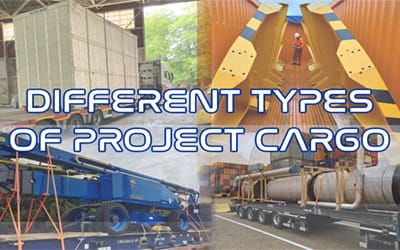4 Essential Project Cargo Types Every Logistics Professional Must Know
Project cargo represents one of the most complex and challenging segments of the logistics industry, encompassing specialised transportation solutions for oversized, overweight, and high value equipment that cannot be handled through conventional shipping methods. Understanding the distinctions between break bulk, Out of Gauge (OOG), and heavy haul cargo is essential for logistics professionals navigating this sophisticated marketplace.
For companies like SARR Logistics, expanding into project cargo operations presents significant opportunities to serve clients requiring specialised machinery transport, crating services, and escort vehicle coordination. The project cargo sector demands comprehensive expertise in regulatory compliance, route planning, and multimodal transport coordination across both UK and international corridors.
Break Bulk Cargo: Foundation of Project Logistics
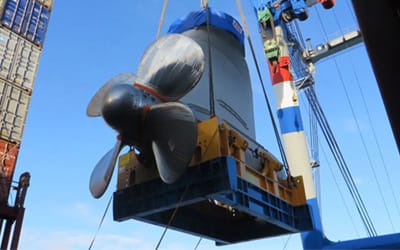 Break bulk cargo represents goods that cannot fit inside standard shipping containers due to size, shape, or weight constraints. The terminology originates from the historical practice of “breaking bulk” the process of unloading portions of cargo from ships piece by piece rather than in standardised units.
Break bulk cargo represents goods that cannot fit inside standard shipping containers due to size, shape, or weight constraints. The terminology originates from the historical practice of “breaking bulk” the process of unloading portions of cargo from ships piece by piece rather than in standardised units.
Unlike containerised cargo that utilises uniform handling procedures, break bulk requires individual lift on / lift off handling using specialised equipment such as heavy duty cranes, gantries, and mobile lifting apparatus. This cargo category includes construction machinery, industrial equipment, steel structures, and manufacturing components that exceed standard container dimensions.
Break bulk operations typically utilise multipurpose vessels equipped with onboard cranes and specialised handling systems. These ships feature cargo holds designed to accommodate irregular shapes and substantial weights, often with reinforced deck structures capable of supporting concentrated loads that would exceed container ship specifications.
Break Bulk Handling Requirements
The logistics complexity of break bulk cargo extends beyond simple transportation to encompass comprehensive planning and coordination. Port infrastructure requirements include heavy duty handling equipment, adequate storage space, and specialised securing systems to prevent cargo shifting during transit.
Documentation for break bulk shipments involves detailed cargo descriptions, dimensional specifications, weight distributions, and lifting point calculations. Cargo securing becomes critical, requiring adherence to UK government regulations and international standards for load stabilisation and structural integrity.
For logistics providers, break bulk cargo presents opportunities to offer value added services including cargo surveying, custom crating solutions, and specialised packaging designed to protect high value equipment during international transit.
Out of Gauge (OOG): Exceeding Standard Dimensions
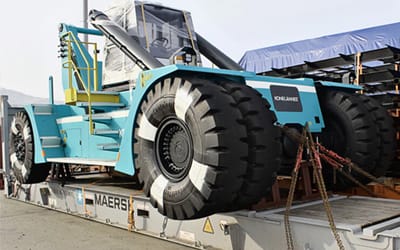 Out of Gauge cargo specifically refers to shipments that exceed standard container dimensions, typically measuring more than 2.4 metres wide, 2.6 metres high, or 12 metres long. OOG cargo requires specialised handling procedures and equipment due to irregular dimensions that prevent conventional container utilisation.
Out of Gauge cargo specifically refers to shipments that exceed standard container dimensions, typically measuring more than 2.4 metres wide, 2.6 metres high, or 12 metres long. OOG cargo requires specialised handling procedures and equipment due to irregular dimensions that prevent conventional container utilisation.
The dimensional constraints that define OOG cargo create unique logistical challenges requiring route surveys, infrastructure assessments, and careful coordination with port authorities and transport operators. These shipments often utilise flat rack containers, open-top containers, or specialised project cargo vessels designed to accommodate oversized dimensions.
OOG cargo frequently includes wind turbine components, industrial modules, prefabricated structures, and manufacturing equipment that cannot be disassembled without significant cost or risk of damage. The transportation of such cargo demands expertise in dimensional analysis, structural engineering, and regulatory compliance across multiple jurisdictions.
OOG Transportation Planning
Successful OOG cargo operations require comprehensive planning beginning with detailed cargo surveys and dimensional verification. Route analysis must consider bridge clearances, road width restrictions, and port infrastructure capabilities to ensure feasible transportation pathways.
International OOG movements involve coordination with multiple authorities including port operators, customs agencies, and transport regulators. The complexity of documentation includes detailed technical drawings, weight distribution calculations, and structural integrity certifications.
SARR Logistics’ experience with oversized machinery transport provides valuable foundation knowledge for expanding into OOG cargo operations, particularly in understanding escort vehicle requirements and dangerous goods declarations when applicable.
Heavy Haul Transport: Managing Exceptional Weights
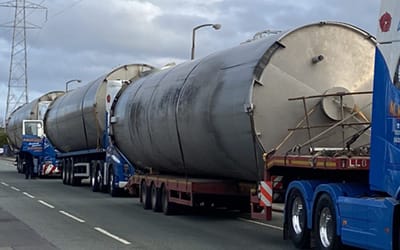 Heavy haul transport specialises in moving cargo that exceeds standard weight limitations, typically involving loads over 44,000 kilograms that require specialised vehicles and route planning. According to UK regulations, heavy haul operations fall under Special Types General Orders (STGO) with specific categories based on total vehicle weight.
Heavy haul transport specialises in moving cargo that exceeds standard weight limitations, typically involving loads over 44,000 kilograms that require specialised vehicles and route planning. According to UK regulations, heavy haul operations fall under Special Types General Orders (STGO) with specific categories based on total vehicle weight.
The UK’s STGO framework classifies heavy haul operations into three categories: STGO 1 (up to 50,000 kg), STGO 2 (up to 80,000 kg), and STGO 3 (over 80,000 kg). Each category requires specific permits, route notifications, and compliance with dimensional and operational restrictions designed to protect road infrastructure and ensure public safety.
Heavy haul vehicles utilise specialised trailers including low loaders, multi axle configurations, and self propelled modular transporters (SPMTs) capable of distributing substantial weights across multiple axles to minimise road surface pressure and structural damage.
Heavy Haul Regulatory Compliance
UK heavy haul operations require notification to police, highway authorities, and bridge owners through the Electronic Service Delivery for Abnormal Loads (ESDAL) system operated by National Highways. This system facilitates route planning, authority notification, and coordination with infrastructure managers.
The regulatory framework includes mandatory escort vehicle requirements for certain weight categories, specific operating hour restrictions, and speed limitations designed to minimise traffic disruption and ensure safe operations. Heavy haul operators must maintain comprehensive insurance coverage and demonstrate compliance with vehicle construction standards.
International heavy haul movements require coordination with multiple national regulatory systems, each with distinct permit requirements, dimensional restrictions, and operational procedures. Understanding these variations is essential for successful cross border project cargo operations.
Project Cargo: Integrated Logistics Solutions
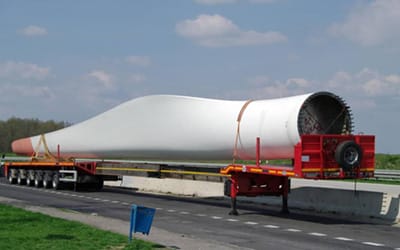 Project cargo encompasses the comprehensive planning and execution of complex transportation requirements involving multiple cargo types, multimodal transport solutions, and coordinated delivery schedules. This category typically supports large scale industrial projects including power generation facilities, manufacturing installations, and infrastructure developments.
Project cargo encompasses the comprehensive planning and execution of complex transportation requirements involving multiple cargo types, multimodal transport solutions, and coordinated delivery schedules. This category typically supports large scale industrial projects including power generation facilities, manufacturing installations, and infrastructure developments.
The International Federation of Freight Forwarders Associations (FIATA) recognises project cargo as requiring specialised expertise in logistics planning, regulatory compliance, and risk management. FIATA’s standards emphasise the importance of comprehensive project planning, stakeholder coordination, and documentation management for successful project cargo execution.
Project cargo operations often combine break bulk, OOG, and heavy haul elements within single projects, requiring integrated logistics solutions that address multiple transportation challenges simultaneously. These projects demand expertise in cargo engineering, route analysis, and multimodal transport coordination.
Project Cargo Documentation and Planning
Successful project cargo operations require comprehensive documentation including cargo inventories, dimensional surveys, weight calculations, and transportation schedules. Project planning must consider delivery sequencing, storage requirements, and assembly coordination to ensure project timeline adherence.
Risk management becomes critical in project cargo operations due to high cargo values, complex transportation requirements, and tight delivery schedules. Insurance considerations include cargo value protection, transportation liability, and project delay coverage to protect against unforeseen circumstances.
For companies entering project cargo markets, understanding client requirements, regulatory frameworks, and technical capabilities is essential for competitive positioning and operational success.
UK Regulatory Framework for Project Cargo
The UK’s regulatory approach to project cargo operations emphasises safety, infrastructure protection, and traffic management through comprehensive permit systems and operational controls. The Special Types General Order framework provides structured guidelines for abnormal load operations whilst maintaining operational flexibility for legitimate business requirements.
Abnormal Indivisible Load (AIL) regulations define cargo that cannot be divided without undue expense or damage risk, providing legal framework for oversized and overweight transportation. The regulations specify dimensional limits, weight restrictions, and operational requirements designed to balance commercial needs with public safety considerations.
Route planning requirements include advance notification periods, escort vehicle specifications, and infrastructure impact assessments. Operators must demonstrate technical competence, maintain appropriate insurance coverage, and comply with vehicle construction standards specific to abnormal load operations.
International Compliance Considerations
International project cargo operations involve coordination with multiple regulatory frameworks, each with distinct requirements for permits, documentation, and operational procedures. European Union regulations harmonise certain aspects of abnormal load transport whilst maintaining national sovereignty over infrastructure protection and traffic management.
Understanding international regulatory differences is essential for successful cross border project cargo operations. Factors include permit validity periods, escort vehicle requirements, operational hour restrictions, and documentation standards that vary significantly between jurisdictions.
SARR Logistics’ experience with international logistics operations provides valuable foundation knowledge for understanding regulatory complexity and coordination requirements essential for successful project cargo operations.
Cost Factors and Economic Considerations
 Project cargo operations involve complex cost structures reflecting specialised equipment requirements, regulatory compliance costs, and operational complexity. Primary cost factors include specialised transport equipment, escort vehicle services, permit fees, and route preparation expenses.
Project cargo operations involve complex cost structures reflecting specialised equipment requirements, regulatory compliance costs, and operational complexity. Primary cost factors include specialised transport equipment, escort vehicle services, permit fees, and route preparation expenses.
Transportation costs for project cargo typically exceed conventional freight rates due to dedicated vessel requirements, specialised handling equipment, and extended transit times. Additional costs include cargo insurance, survey fees, and documentation expenses specific to oversized and overweight cargo operations.
Economic planning for project cargo requires comprehensive cost analysis including transportation, handling, storage, and insurance components. Understanding these cost structures is essential for competitive pricing and project profitability analysis.
Value Added Service Opportunities
Project cargo operations create opportunities for value added services including cargo surveying, custom packaging solutions, and project logistics management. These services generate additional revenue whilst strengthening client relationships through comprehensive solution provision.
Specialised services such as route surveys, permit acquisition, and escort coordination provide differentiation opportunities for logistics providers entering project cargo markets. Technical expertise in cargo engineering, regulatory compliance, and project management creates competitive advantages in this specialised sector.
For SARR Logistics, leveraging existing expertise in machinery transport, crating services, and escort coordination provides foundation capabilities for expanding into comprehensive project cargo operations across UK and international markets.
SARR Logistics offers comprehensive expertise in specialised cargo handling, international transport coordination, and regulatory compliance support for companies requiring project cargo solutions. Our experience with oversized machinery transport and customs clearance provides valuable foundation for supporting clients’ project cargo requirements.
 Contact our experienced team at [email protected] or call 0333 224 1 224 to discuss how we can support your project cargo requirements. From air freight services to comprehensive supply chain mapping, SARR Logistics delivers the specialised expertise your complex logistics projects require.
Contact our experienced team at [email protected] or call 0333 224 1 224 to discuss how we can support your project cargo requirements. From air freight services to comprehensive supply chain mapping, SARR Logistics delivers the specialised expertise your complex logistics projects require.
Conclusion
Understanding the distinctions between break bulk, OOG, heavy haul, and integrated project cargo is essential for logistics professionals navigating this complex and rewarding sector. Each cargo type presents unique challenges requiring specialised expertise, regulatory knowledge, and operational capabilities that differentiate successful project cargo providers.
The project cargo sector offers significant opportunities for logistics companies with appropriate technical capabilities, regulatory expertise, and operational infrastructure. Success requires comprehensive understanding of client requirements, regulatory frameworks, and technical solutions that address complex transportation challenges.
For companies considering expansion into project cargo operations, building expertise through strategic partnerships, technical training, and operational experience provides foundation for long term success in this specialised and profitable logistics sector.
FAQ
What is the difference between break bulk and OOG cargo?
Break bulk cargo refers to goods that cannot fit in standard containers due to size, shape, or weight, requiring individual handling and specialised vessels. OOG (Out of Gauge) cargo specifically exceeds standard container dimensions but may still utilise modified container solutions such as flat racks or open-top containers for transportation.
What permits are required for heavy haul transport in the UK?
UK heavy haul transport requires STGO (Special Types General Order) compliance with notifications through the ESDAL system to police, highway authorities, and bridge owners. Specific requirements include advance notification periods, escort vehicle coordination, and adherence to weight and dimensional restrictions based on cargo category.
How do I calculate costs for project cargo operations?
Project cargo costs include transportation equipment, permits, escort services, insurance, and handling fees. Pricing typically uses metric ton or cubic metre calculations with additional charges for specialised equipment, route surveys, and documentation requirements. Accurate dimensional and weight specifications are essential for precise cost estimation.
What insurance coverage is needed for project cargo?
Project cargo insurance should include cargo value protection, transportation liability coverage, and potential delay insurance for time sensitive projects. Coverage must address high cargo values, specialised handling risks, and multimodal transport requirements across different jurisdictions and transport modes.
When should companies consider using project cargo services?
Companies should consider project cargo services for oversized, overweight, or high value equipment that cannot utilise standard shipping methods. This includes industrial machinery, construction equipment, manufacturing modules, and infrastructure components requiring specialised handling, documentation, and transportation expertise.


